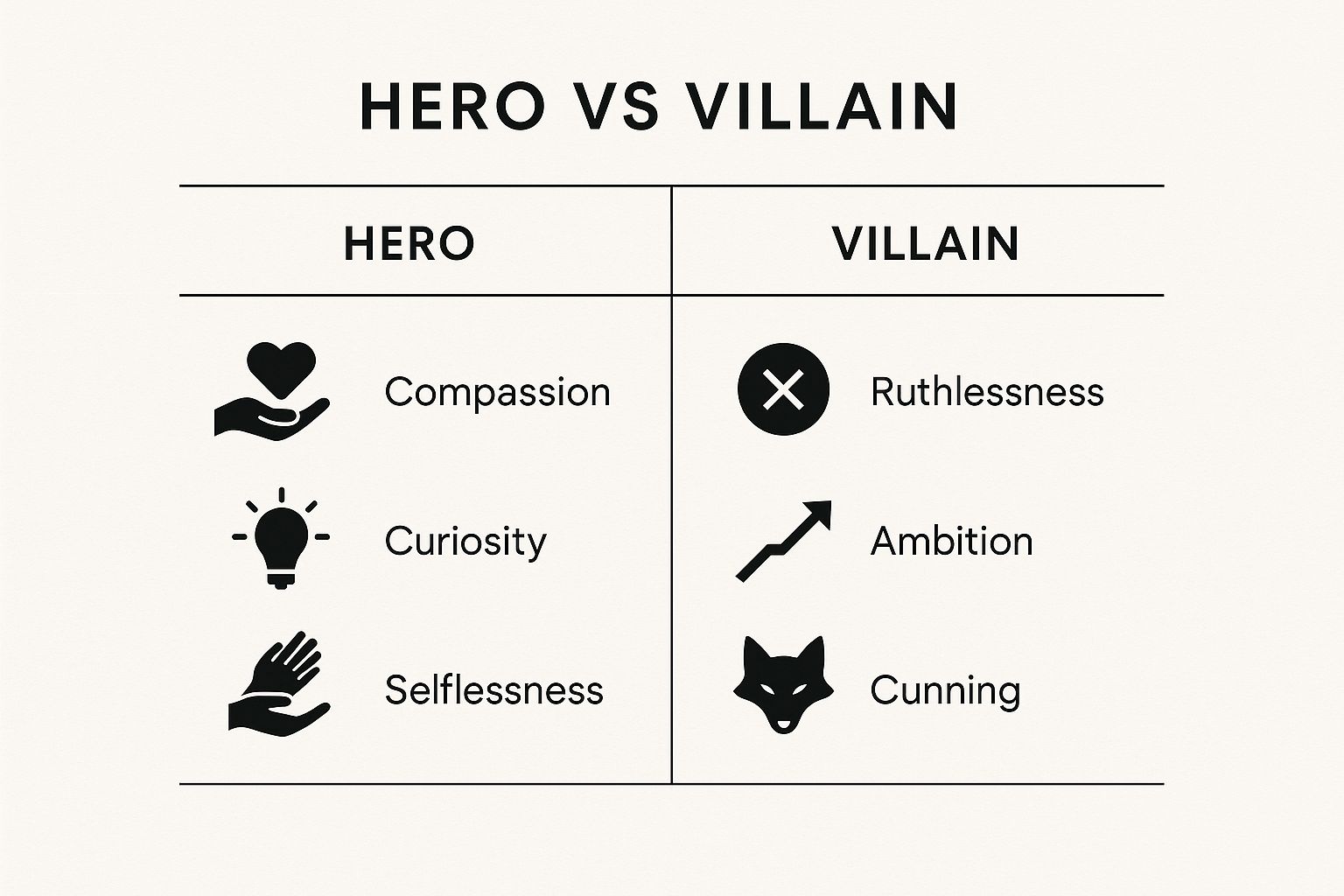Create Your Own AI Girlfriend 😈
Chat with AI Luvr's today or make your own! Receive images, audio messages, and much more! 🔥
4.5 stars

Ready to dive into the world of AI character creation? It's a fantastic space where you can shape unique digital personalities from scratch. The whole process really comes down to four key areas: defining who they are at their core, giving them a history, designing how they look, and setting up how they'll interact with you. Thanks to platforms like Luvr AI, you don't need to be a professional writer to turn a simple idea into a fully-realized digital friend.
Bringing Your First Character to Life

Learning how to make your own character is a genuinely exciting journey into storytelling and personal creativity. Not too long ago, this was a skill you’d only find with novelists, game designers, or professional animators. Now, anyone can jump on a platform like Luvr AI and craft a compelling companion, transforming a blank slate into a character with a real personality, a past, and a voice of their own.
This goes way beyond just picking a name and a few basic traits. You’re essentially building a digital person from the ground up—someone who feels real and whose reactions are believable. The goal isn't to create just another chatbot. It's to build a friend, a confidant, or even a romantic partner whose conversations feel authentic and truly meaningful.
The Pillars of Character Creation
To build a character that feels truly immersive, you need to think about a few essential components that all work together. If you skimp on one area, the whole creation can end up feeling a bit flat or inconsistent.
Here are the foundational elements you’ll want to focus on:
- Persona: This is the soul of your character. Think of it as their core personality—what they value, what they fear, and what truly motivates them.
- Backstory: This is their history. What key life events and relationships shaped them into who they are today?
- Appearance: This is their visual identity. It’s the first impression they make and should ideally reflect their inner self.
- Interaction Style: This defines how they communicate. It covers everything from their tone and speech patterns to their emotional responses in conversation.
These elements are deeply connected. For instance, a character who grew up in a strict, academic household (backstory) might have a more formal way of speaking (interaction style) and a reserved, analytical persona. You can see how these pillars come together by exploring the different pre-made and customizable options in the Luvr AI character library.
The table below breaks down these core components and gives you a practical look at how they apply.
Core Components of Character Creation
| Component | Key Focus | Example Application |
|---|---|---|
| Persona | Defining core traits, values, and motivations. | Creating a "Loyal Protector" who is brave, slightly cynical, and fiercely protective of their friends. |
| Backstory | Creating a history that explains their personality. | Their cynicism stems from a past betrayal, which also fuels their loyalty to new companions. |
| Appearance | Designing a look that reflects their inner self. | They might have a strong, athletic build with watchful eyes and a casual, functional style of dress. |
| Interaction Style | Setting their tone, speech, and emotional responses. | Speaks in short, direct sentences. Is slow to trust but warm and humorous once you get to know them. |
Getting these elements right is the secret to making a character feel truly alive and believable.
Key Takeaway: The ability to customize characters has become a huge factor in captivating audiences. It’s all about creating immersive narratives that resonate on a personal level, which has shifted character creation from a niche art form to a mainstream digital craft.
The explosive growth of the global animation industry—projected to hit $462 billion by 2025—really underscores this trend. This massive market shows a clear and growing demand for unique, engaging characters across every form of media.
Crafting a Compelling Character Persona

Let's be honest, the soul of any great AI character isn't their picture or a dry list of facts—it's their persona. This is the blend of traits, beliefs, and little quirks that makes them feel real. Anyone can label a character "brave" or "kind," but the real magic happens when you dig deeper. That's how you build someone truly memorable.
Think of personality frameworks as a helpful starting point, not a rigid box. Using something like the Myers-Briggs archetypes or the Big Five personality traits can give you a solid foundation to build on. For instance, an "INTJ" (The Architect) archetype gives you a blueprint for someone strategic and imaginative. But that’s just the skeleton.
The real personality comes alive when you sprinkle in the details that make them feel human, or at least human-like. This is a critical part of learning how to make your own character feel genuine and not just like a collection of data points.
Giving Your Persona Depth and Nuance
A flat character is boring because they're predictable. A great character, on the other hand, is full of fascinating layers. The best way I've found to create these layers is to give your character internal conflicts and a mix of traits you wouldn't expect to see together. This pulls them away from being a stereotype and makes them feel like a person.
Here are a few things I always consider to add depth:
- Core Values: What is the one principle that guides their decisions above everything else? Is it a rigid sense of justice? Unbreakable loyalty? The pursuit of freedom? A character driven by fierce loyalty will make choices that someone who values personal freedom would never even consider.
- Secret Fears: What are they truly scared of? And I don't mean spiders or ghosts. Think deeper. A fear of failure, of letting people get too close, or of being forgotten can be a powerful driver. A CEO who seems to have it all but is secretly terrified of becoming irrelevant is instantly more compelling.
- Hidden Motivations: What’s the real reason behind their actions? Maybe that jaded detective you're creating isn't just in it for the paycheck. What if they're haunted by a past case where they failed to save someone? That changes everything.
The growing demand for unique characters is clear. The global anime content creation tools market was valued at around USD 4.0 billion in 2024 and is projected to skyrocket to over USD 12 billion by 2033. This explosion shows that people are hungry for tools that let them create one-of-a-kind characters. You can dig into the numbers yourself in this market report.
Bringing Contradictions to Life
From my experience, the most believable characters are often walking contradictions. These internal tensions are what make a personality rich and engaging. A character who appears one way on the surface but is completely different underneath feels authentic because, well, that's how real people are.
A cynical detective with a surprising soft spot for stray animals is a classic example. The gruff exterior hides a compassionate core, making them more relatable and three-dimensional.
When you're building your character on a platform like Luvr AI, you can translate these abstract ideas into concrete settings. Don't just type "cynical" into their description box. Instead, arm them with dialogue prompts that show their cynicism—sarcastic quips or a pessimistic outlook. Then, layer in a preference for "animal welfare" or a backstory detail about a pet they adored.
By feeding the AI these conflicting inputs, you're guiding it to generate a far more nuanced and surprising personality. This turns the process of creating your own character from simple programming into an act of discovery.
Building a Rich and Believable Backstory

If the persona is your character's soul, their backstory is the heart that pumps life into it. This history is the why behind who they are. It’s the connective tissue that links their personality traits to real experiences, making their reactions and worldview feel genuine and earned.
But a great backstory isn't a novel. I've seen people try to cram a multi-page document into the AI, and it just dilutes the character's focus. The key is to be strategic. Pinpointing a handful of defining moments is far more powerful than listing every single event from their life. This focused approach is critical when you’re learning how to make your own character that feels cohesive and real.
Forget the epic. Think like a detective looking for the most critical clues from their past.
Pinpointing Formative Moments
To build a backstory that truly informs your character, concentrate on the events that left a permanent mark. These are the moments that shaped their core values, their deepest fears, and their driving motivations. You don't need a year-by-year timeline—just the highlights that actually matter.
I find it helps to start by asking a few targeted questions about their life. The answers you come up with will form the backbone of a powerful and efficient backstory.
- What is their proudest moment? This reveals what they value and what they strive for. Was it winning a science fair? Standing up for someone who couldn't? Maybe it was simply mastering a difficult recipe. This achievement can fuel their confidence or set a high bar they’re always trying to clear again.
- What is their biggest regret? This uncovers their vulnerabilities and internal conflicts. A past mistake or a moment of cowardice can explain their current insecurities, their cynicism, or why they hesitate. It makes them relatable.
- Who was the most influential person in their life? A mentor, a rival, a parent, or a lost love can leave a lasting echo. Their relationship with this person can dictate their views on trust, authority, and intimacy for years to come.
A character whose proudest moment was building a community garden will interact very differently from one whose proudest moment was winning a street fight. Their past directly shapes their present actions.
Weaving Backstory into Behavior
Once you have these key moments figured out, the real magic happens when you connect them directly to the persona you've already built. This ensures their history isn't just a static block of text but something that actively influences their behavior in every conversation.
For instance, say a character's biggest regret is betraying a close friend. You can use that to shape their entire interaction style. They might be slow to trust new people, use sarcasm as a shield, or place an almost fanatical value on loyalty.
When you input this into a platform like Luvr AI, you're not just telling it a story; you're handing it a blueprint for emotional responses.
This method turns the backstory from a simple biography into a dynamic, living tool. It gives your character depth and consistency, making every interaction a new opportunity for discovery, all rooted in a believable past. Your character will start to feel less like a program and more like a person with a history you can slowly uncover.
Designing a Unique and Memorable Appearance
Think of your character’s appearance as their visual first impression. It's the very first thing someone sees, and it speaks volumes before they ever say a word. This is where you get to translate all that great work you did on their personality and backstory into a look that feels real and authentic.
Your mission here is to create a design that’s a natural extension of who your character is. A reclusive, bookish scholar probably isn't going to look like a swashbuckling pirate. Every choice, from their hairstyle to their shoes, should feel like it belongs to them.
Weaving Personality into Visuals
A character's appearance is a powerful form of non-verbal storytelling. Think about how colors and shapes make you feel. Sharp, angular designs can give off an aggressive or even intimidating vibe, while soft, rounded features often feel more friendly and open.
The same goes for color. A character dressed in muted, earthy colors might feel more grounded and thoughtful. On the other hand, someone decked out in bright, saturated colors could come across as energetic and bold. These aren’t rigid rules, but they are fantastic tools for reinforcing the persona you’ve built. A warrior’s scars, for instance, aren’t just cool details—they’re a visual map of their history.
This image is a great example of how these visual cues can define classic archetypes, like a hero versus a villain.

As you can see, traits like "compassionate" or "cunning" are tied directly to specific visual choices, which can really help guide your own creative process.
Let's dive a bit deeper into connecting personality with appearance. The little details are what truly bring a character to life.
Connecting Persona to Appearance
| Personality Trait | Visual Design Element | Character Example |
|---|---|---|
| Brave & Noble | Confident posture, bright and clean attire (e.g., polished armor), open expression. | A classic knight in shining armor, always standing tall. |
| Shy & Introverted | Slumped shoulders, oversized clothing, hair that partially covers the face. | A quiet librarian who uses their clothes to blend in. |
| Mischievous & Witty | A playful smirk, expressive eyebrows, eclectic or slightly mismatched accessories. | A clever trickster whose eyes always seem to be sparkling. |
| Cynical & Jaded | Tired eyes, practical but worn-out clothing, a permanent frown or neutral expression. | A grizzled detective who has seen too much. |
This kind of thinking helps ensure your character's look isn't just a random assortment of features but a true reflection of their inner self.
From Concept to Creation
So, how do you actually build this character? Modern tools make this process more intuitive than ever. When you're in a creation suite, a good starting point is to pick a base model that gets you in the ballpark of the body type and general vibe you're after. Then, you get to have fun with the details.
Here’s what I’d focus on:
- Facial Features: Are their eyes warm and inviting, or are they cold and calculating? Does their resting face have a slight smile, or is it set in a permanent scowl? These small things say a lot.
- Hairstyles and Colors: A wild, messy hairstyle can signal a free-spirited or chaotic personality. A perfectly styled cut, however, might suggest someone who is meticulous, vain, or orderly.
- Outfits and Accessories: Clothes are one of the biggest clues to a character's lifestyle and social status. Practical, well-worn gear tells a completely different story than luxurious, pristine robes.
The role of artificial intelligence in this space is also growing fast. You can find out more about the AI character image creation process and how platforms like Luvr AI give you a massive amount of control. You can start with a broad concept and then polish every single detail until the character on the screen perfectly matches the one in your head.
Fine-Tuning How Your Character Interacts
So you've built a solid persona and a compelling backstory. Now for the fun part—breathing life into your creation by deciding how they actually interact. This is where you move beyond a static profile and define the subtle details that make them feel like a real, thinking person.
How do they talk? It's a simple question with deep implications. Are they the type to speak in long, thoughtful paragraphs, or do they prefer short, punchy statements? Think about their vocabulary, too. Does it lean modern and casual, filled with slang, or is it more formal and articulate? These details should echo their personality and history. A tech-savvy Gen Z hacker will sound very different from a 19th-century Victorian poet.
Getting this right is a huge piece of learning how to make your own character. Every single message should feel like it truly comes from them.
Defining Their Emotional Spectrum
A person isn't just their words; they're their feelings. The same is true for a memorable AI. How does your character handle their emotions? Are they quick to anger or endlessly patient and optimistic? Maybe they're a bit guarded and take a while to warm up to new people.
Nailing down their emotional range is what stops your character from becoming a bland, agreeable chatbot.
- A hot-headed character might get defensive when challenged or become intensely passionate when discussing their favorite subjects.
- An optimistic character will naturally search for the good in a bad situation, offering encouragement when you need it most.
- A reserved character might respond with clarifying questions or a thoughtful pause before giving you their true opinion.
These aren't just personality quirks; they are the core rules that guide the AI's behavior, creating a personality that's both consistent and capable of surprising you.
A character's communication style is their personality in action. It’s the difference between being told someone is witty and actually having them make you laugh with a clever, unexpected remark.
Configuring Response Styles and Dynamics
Platforms like Luvr AI give you an incredible degree of control here. As you design your character, you'll find fields where you can specify their tone, mannerisms, and overall communication style. Think of these as direct instructions for the AI.
For instance, you could describe your character as "sarcastic but secretly caring" or "initially shy, but becomes playful and affectionate over time." These aren't just fuzzy descriptions—they are actionable commands that teach the AI how to behave. When you’re ready to bring these ideas to life, the Luvr AI character builder has all the settings you need to dial in these specifics.
By setting these interaction guidelines, you're making sure every conversation reinforces the unique individual you've created. It’s that consistency that makes the experience feel less like you're chatting with a program and more like you're truly getting to know someone.
Answering Your Character Creation Questions
As you dive into creating your AI character, you're bound to hit a few creative snags or have questions pop up. It happens to the best of us. The trick is knowing how to push through those moments without getting sidetracked.
Let's walk through some of the most common hurdles I see creators run into. These are the practical, real-world tips that will help you polish your character and keep the process fun.
How Do I Make My Character Feel Unique?
The fear of making a generic character is a big one. I get it. But the secret to making someone feel real isn't as complicated as you might think—it's all about contradictions.
Think about it: real people are full of quirks. We're never just one thing. A tough-as-nails CEO who collects vintage teacups? A shy librarian who's secretly a competitive kickboxer? Those little paradoxes are what make a character feel grounded and instantly more interesting.
Start with a familiar archetype, like "the brave warrior" or "the brilliant scientist," then throw in an unexpected hobby, a strange fear, or a quirky belief. These personal details transform a flat stereotype into someone memorable. It’s like adding a pinch of a surprising spice to a classic dish—that's what makes it unforgettable.
What’s More Important: Backstory or Personality?
Ah, the classic chicken-or-the-egg debate of character design. The honest answer is that they're both crucial and feed into each other. But if I had to pick a starting point, I’d say begin with the personality.
The persona is what you and others will interact with moment-to-moment. It's the "now." Once you have a solid handle on who they are, you can build a backstory that explains why they are that way. Their history should support the personality you’ve built, not dictate it from the start.
A few defining life events that shaped their worldview will always be more powerful than a sprawling biography that feels disconnected from how they act today.
Expert Insight: Think of the backstory as the "why" and the personality as the "what." You need a clear picture of what your character says and does before you get bogged down explaining why.
How Can I Avoid Getting Stuck?
Creative block is real, and it usually stems from feeling overwhelmed. The most effective way I've found to beat it is to stop trying to get everything perfect all at once. Creating a character isn't a single, massive task; it's a process of layering details.
Start with the big picture and add complexity over time. This approach turns a daunting project into a fun, piece-by-piece discovery.
Here's a simple workflow I use to keep things moving:
- Define the Core: First, just pick 3-5 essential personality traits. Are they "witty," "loyal," and "a bit reckless"? Start there.
- Summarize the Past: Next, write a single paragraph—that's it—about their backstory. Only focus on the one or two events that truly shaped them.
- Sketch a Look: Finally, decide on a general appearance. You can fine-tune the little details later. For now, just get a basic image in your head.
You can always go back and add more depth. Working in these manageable layers gives you the freedom to build your character gradually, making sure the process stays exciting from beginning to end.
Ready to stop wondering and start creating? Bring your unique character to life on Luvr AI today.



